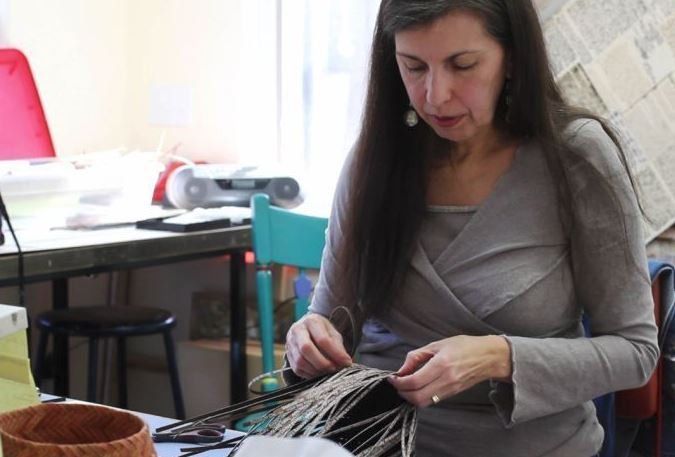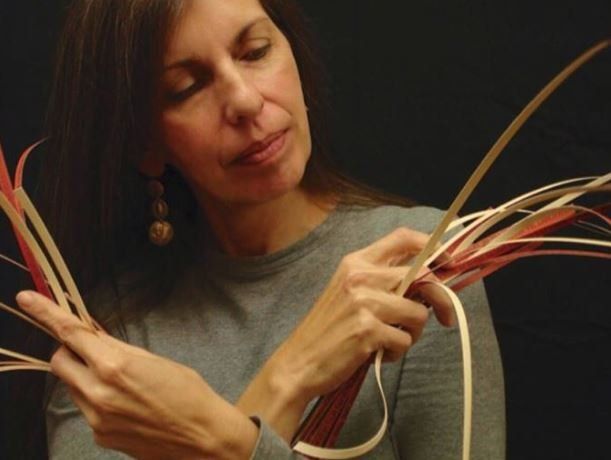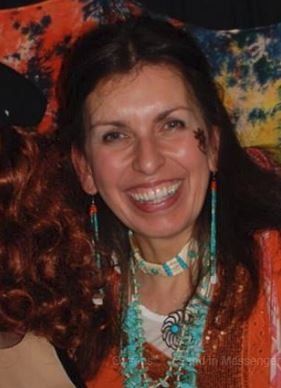
Shan Goshorn 1957-2018
Shan Goshorn, 1957-2018
Wing It & Tulsa Audubon sadly acknowledges the loss of one of our founders, the artist and advocate Shan Goshorn. While so many in the world recognize her amazing talents in photography, painting, and (particularly) weaving, we would like to add something from our small corner of the world in farewell.
Shan loved the birds.
Her passion for avian souls continued when her career took off and the demands for her baskets surpassed her time to rehabilitate songbirds, but even then, she annually donated from her success to the organization. She gave us her aviary so another rehabber could have a top-notch structure for helping wildlife; she donated art for our fundraisers.
A sweet secret: even after she quit rehabbing songbirds, Shan remained a mealworm mama. She regularly ordered several hundred super worms, keeping them in containers in her studio. Kim Doner got the dubious honor of worm-sitting when Shan was out of town, which happened more and more often for the experimental cancer treatments - but on her good days, she relished sitting outside and whistling an invitation.
Dozens of songbirds would appear from nowhere, shamelessly begging for those worms. Whether they'd been raised and released by her all those years ago or not, bluejays and mockingbirds and thrashers and woodpeckers and cardinals and robins swept down for the gifts Shan offered.
A few weeks ago, Shan was in a lot of pain; hospice had come to assist with additional drugs. While Kim sat beside her, Shan focused across the room and pointed. "Look at that! There's a red-headed woodpecker sitting on the back of that chair!".
But there wasn't.
Unless, of course, there was.
Kim Donor

Make a donation to WingIt in memory of Shan



Shan Goshorn, Cherokee artist and activist from Tulsa, dies at 61
Shan Goshorn, a Tulsa artist and activist hailed for her innovative take on traditional Native American basket weaving, which she used to make pointed statements on contemporary issues, died Saturday.
She was 61.
A memorial service is set for 2 p.m. Dec. 29 at the Gilcrease Museum.
Goshorn had been battling a rare form of cancer.
Goshorn’s work as a basket weaver was considered groundbreaking, and won her international acclaim and a place in permanent collections at the Smithsonian Institution and other museums.
Her work is currently on display at Crystal Bridges in Bentonville, Arkansas, in the exhibit “Art for a New Understanding: Native Voices, 1950s to Now;” as well as in a solo exhibit at Dickinson College’s Trout Gallery in Carlisle, Pennsylvania. Galleries around the state have also featured Goshorn, including a special exhibition of her work at 108 Contemporary in Tulsa in October 2017 during the international conference for the Native American Art Studies Association.
With her baskets, Goshorn, a member of the Eastern Band of Cherokees, borrowed the intricate techniques and patterns of the age-old art form, but used different materials, while weaving in political, social and cultural commentary in both words and images.
“I’ve always done work that’s made very strong statements,” Goshorn told the Tulsa World in 2013. “And, in the past, sometimes the art itself has been pretty confrontational and in-your-face.
“But while the baskets are presenting the same kind of statements, they seem to draw people in rather than pushing them away. They engage the audience in a new kind of way, so that they want to know the whole story each piece contains.”
Often in her artistic statements, Goshorn took on human rights issues and challenged stereotypes, especially as they concerned Native Americans. On various of her baskets she incorporated the texts of treaties between the Cherokees and the U.S. government; maps that delineate what were once Cherokee lands; and lists of sports teams and products that use Indian names.
Christina Burke, curator of Native American art at Philbrook Museum, said, while accomplished in painting, photography and other media, “Shan really found her voice in basket weaving, both literally and figuratively weaving images and texts together ... to bring historical stories to life.”
For Goshorn, each finished piece was a product of time, care and collaboration. She started by researching at archives and libraries, then often reached out to involve other people, Burke said.
Goshorn considered the latter step as vital, she added. For one project, she sought out and photographed native women from around the community. The photos then became the basis for a basket drawing attention to violence against native women, Burke said.
Goshorn’s work won her a number of honors. They included the grand prize at the 2011 Red Earth Indian Art Exhibition in Oklahoma City, and selection for a Smithsonian Artist Research Fellowship and USA Distinguished Fellowship in the field of traditional arts.
Goshorn was a native of Baltimore, Maryland, and graduate of the Atlanta College of Art.
Among other interests, she was passionate about wildlife rehabilitation and was federally certified. For several years she had personally rehabbed a number of migratory songbirds.
Robin Tilly, Goshorn’s best friend and fellow artist, said, “Shan came to the world with a message about justice and kindness and dignity and honoring each other and our ancestors. She exhibited that message with her life and consistently lifted people up. I’m convinced she would want us to continue to use her spirit as a source of inspiration.”
Added Burke: “Shan has been such a vital part of the Tulsa and native art communities for decades and her absence will be felt years to come. But so will her presence: She was such an engaged and prolific artist that her legacy lives on.”
Goshorn’s survivors include her husband of 33 years, Tom Pendergraft; a son, Loma Pendergraft; daughter, Neosha Pendergraft; three stepdaughters, Natalee, Carolee and Sommer Pendergraft; three grandchildren; her mother, Edna Goshorn; and two sisters.
Debra Shan Goshorn
July 3, 1957 - December 1, 2018
Debra Shan Goshorn, 61, passed on December 1, 2018 surrounded by her loving family and friends after a valiant fight against cancer. While her time on earth ended too soon, Shan lived a prolific and abundant personal and professional life. She wove together deeply committed relationships with family and friends and a robust career dedicated to activism. As an Eastern Band Cherokee Indian artist, her multi-media artwork brought light to human rights issues, particularly those that affect Native American people today. She also cared deeply for animals, with a special love for birds, and was a federally certified wildlife rehabilitator.
Shan leaves her loving husband of 33 years, Tom Pendergraft of Tulsa, Oklahoma. Her immediate family includes daughters, Neosha Pendergraft, Natalee Pendergraft (Erika Hardin), Carolee Pendergraft (fiancé Jason Ashmann), Sommer Pendergraft; and son, Loma Pendergraft. She also leaves behind three grandchildren including Madison Pendergraft, Tanner Pratt and Gavin Bertrand. She is survived by her mother, Edna Saunooke Goshorn and sisters, Diane Goshorn and Donna Goshorn Beck of Cherokee, NC and nephew, Brandon Beck of Sylva, NC. She was preceded in death by her father, John Goshorn, Jr. and grandparents, Stacy and Anderson Saunooke and John Goshorn, Sr.
Shan was born in Baltimore, Maryland on July 3, 1957 and grew up in nearby Bel Air. She spent summers on tribal land in North Carolina learning about her culture and observing traditional Cherokee craftwork. Shan demonstrated artistic talent from a young age. After graduating from Bel Air High School, she attended the Cleveland Institute of Art, transferring for her final year of formal education to the Atlanta College of Art. She moved to Tulsa, OK in 1981 where she lived the remainder of her life. Shan utilized many mediums in her career including hand-tinted photography, paint and metalwork, however, she became most widely known for her basketry. Woven in traditional Cherokee style, her baskets were constructed with contemporary materials such as images, documents, treaties and maps to tell the story of Native people.
Shan had achieved international impact with her work. Her archival materials were requested by and donated to the Smithsonian's National Museum of the American Indian for future scholarly research. She was also identified by the Museum of the Cherokee Indian as the 14th living Cherokee able to create baskets utilizing the difficult double-weave technique.
Her work belongs to over twenty museum collections worldwide and her baskets have traveled extensively carrying Native stories, both traumatic and celebratory, with them.
Shan felt that her work was guided by the ancestors. Now, we will be guided by her. Shan's legacy will not only be the message of her art but the deep kindness, empathy and respect she demonstrated to those around her.
A memorial service will be held on December 29, 2018 at the Gilcrease Museum, 1:00 p.m.
In lieu of flowers, the family requests donations in honor of Shan to the Institute of American Indian Arts (www.iaia.edu), Porta Caeli House end of life care (www.portacaeli.org), Gilcrease Museum (www.gilcrease.org), and Wing It (www.tulsaaudubon.org/wing-it).
The Cherokee language has no word for goodbye.
I tsv go hv ya...We will see you again.
Arrangements are entrusted to Schaudt's Tulsa Funeral Service. Family and friends may share memories and condolences online at schaudtfuneralservice.com